Following the Moorish invasion of the Iberian Peninsula and the first occupation of what became known as al-Andalus, there followed a period of independence
By Nick Nutter | Updated 11 Apr 2023 | Andalucia | History |
Login to add to YOUR Favourites or Read Later
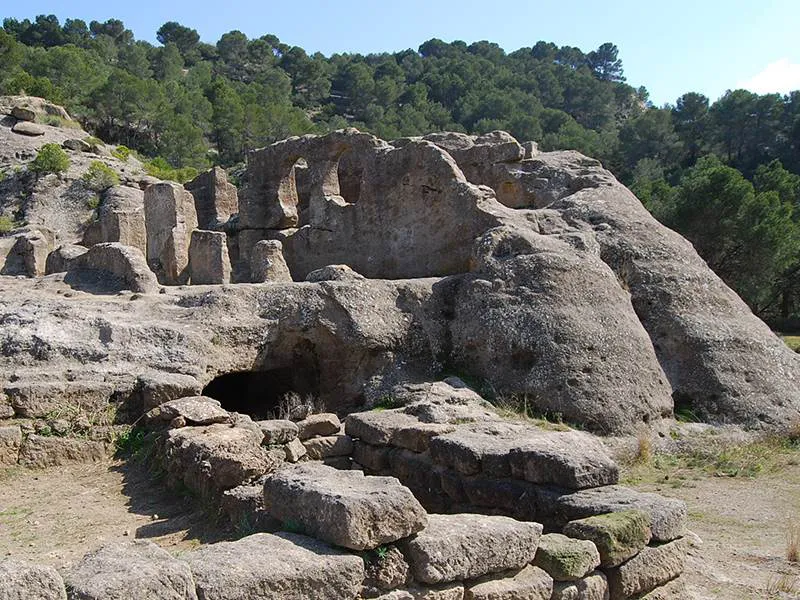
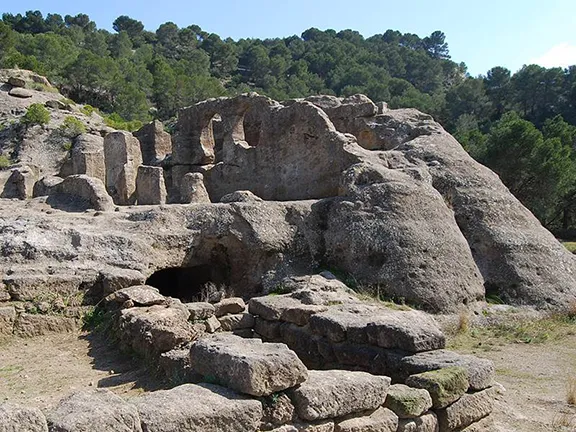
Fortress of Bobastro
Following the invasion of the Iberian Peninsula and the first, unsettled, occupation of what became known as al-Andalus, there followed a period of independence. During this period the main problems faced by succeeding emirs were internal issues as individual governors vied for power and position. They were also troubled by external problems as the never conquered Asturias region and the neighbouring Franks tried to expand their territories taking advantage of an al-Andalus, that, at various times, was weakened by internal strife and a vengeful Abbasid caliphate in Baghdad trying to re-impose the authority of the caliphate. Even the Vikings with bases in the Loire river estuary muscled in. Nevertheless, amongst all the conflict and political shenanigans, advances were made in science, culture, architecture and art.
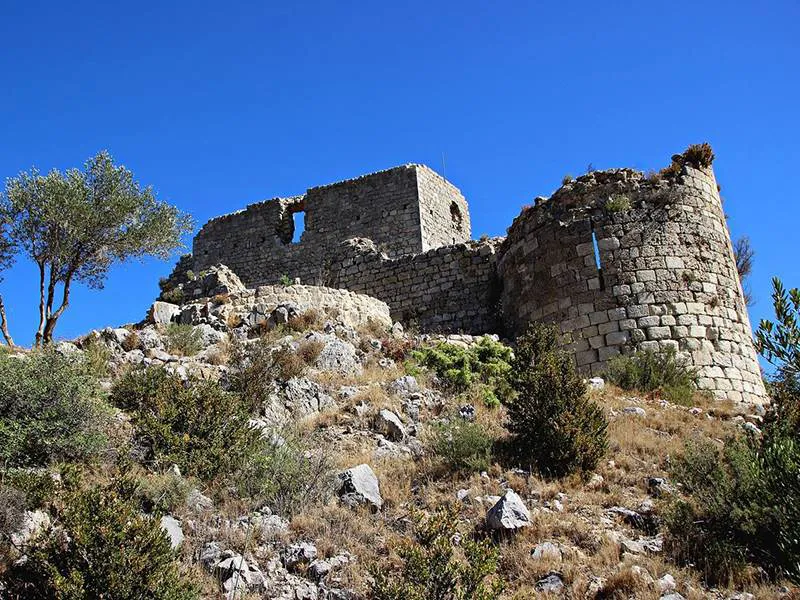
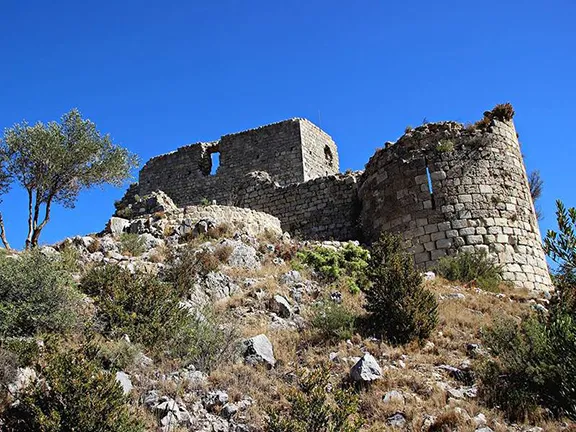
Fortress at Aguilar de la Frontera
In 750 AD, the Abbasids, a family that ruled from Baghdad who went on to supply an unbroken line of caliphs for 300 years, overthrew the Umayyad caliphate that ruled from Damascus and set about slaughtering as many of the Umayyad family as they could. Abd al-Rahman al-Dakhil, an Umayyad prince, escaped and made his way to al-Andalus where he found a country in disarray.
Abd al-Rahman landed somewhere between Almuñécar and Málaga in September 755 AD. He quickly gained support amongst the local population and many of the Syrians, who had thought him dead. He was an astute politician and took advantage of the internecine strife that plagued al-Andalus. Such was the conflict between the Syrian junds, who had been allocated separate fiefdoms by the governor Abu al-Khattar ibn Darar al-Kalbi, and even between towns within the junds, that Abd al-Rahman was able to ‘divide and conquer’.
Within a few weeks of his landing, the city of Zaragoza made a bid for autonomy. The emir of al-Andalus, Yusuf ibn Abd al-Rahman al-Fihri and his Syrian commander and governor of Zaragoza, al-Sumayl ibn Hatim al-Kilabi, were forced to head north to deal with this threat. Abd al-Rahman was able to consolidate his support and in March 756 AD, marched on, and took, Seville with no opposition.
Al-Fihri returned from Zaragoza and the two forces faced each other across the Rio Guadalquivir near Córdoba. Al-Fihri was defeated and taken prisoner along with al-Sumayl. Al-Fihri escaped to Toledo where he was killed and al-Sumayl was garrotted in the jail at Córdoba. Abd al-Rahman proclaimed himself emir of al-Andalus and chose Córdoba to be capital of the Umayyad emirate in the Iberian Peninsula. This was a little premature since most of central and northern al-Andalus, including Toledo, Zaragoza and Barcelona, remained in the hands of supporters of the deceased Yusuf ibn Abd al-Rahman al-Fihri until the submission of Zaragoza in 799 AD.
The new emir sent out word through the Arab world that al-Andalus was a safe haven for friends of the house of Umayya and was soon joined by members of his extended family, many of whom were given high offices throughout al-Andalus.
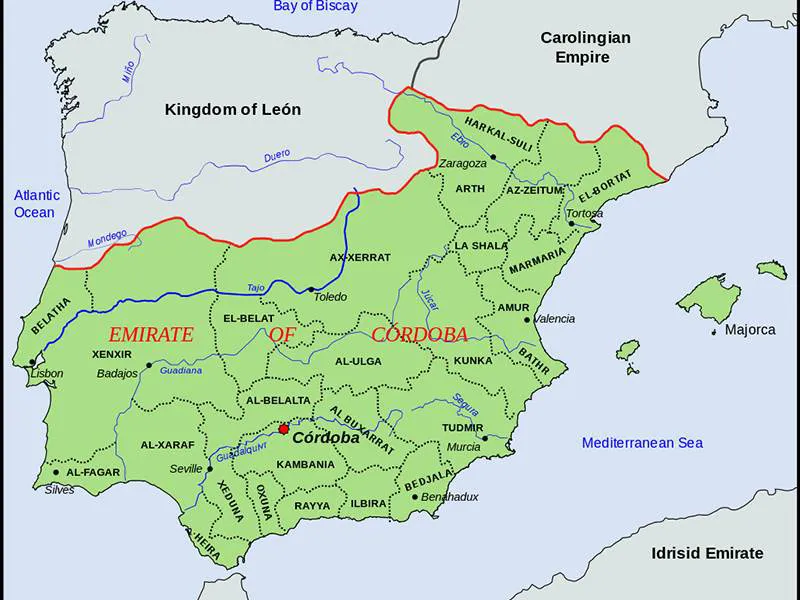
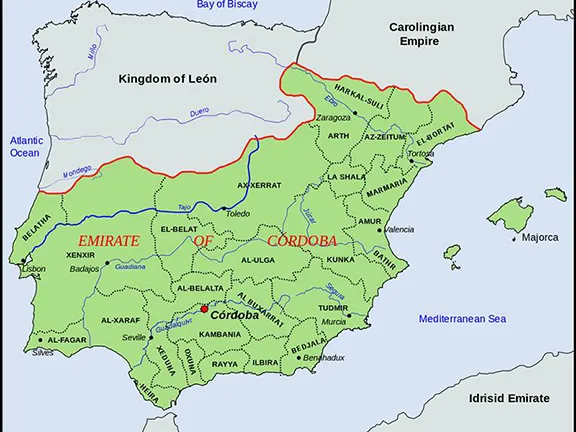
Emirate of Cordoba 929 AD
News of an independent emirate did not please the Abbasid caliph, Abu Ja’far Abdallah ibn Muhammad al-Mansur, back in Baghdad. He appointed al-Ala ibn-Mugith as governor of Africa, a position that notionally gave al-Ala dominion over al-Andalus, at least in al-Mansur’s eyes.
Al-Ala landed an Abbasid army in the vicinity of Beja in Portugal in 763 AD. Much of that area rallied under the Abbasid banner and the combined force marched into the Guadalquivir valley. Abd al-Rahman moved his forces to Carmona where he was besieged for two months. Then, with his forces almost starving, he led them from the city gates into the unprepared Abbasid camp in what has been described as an ‘audacious sally’. Most of the Abbasid army was killed. The heads of the main Abbasid leaders were cut off and preserved in salt. Identifying tags were pinned to their ears, and the heads were then bundled together in a gruesome package and sent to al-Mansur, who was on a pilgrimage to Mecca.
Abd al-Rahman was determined to revenge himself on al-Mansur not only for the invasion of al-Andalus, but also for the slaughter of many of his family during the Abbasid Revolution. Once again it was a self-appointed governor of Zaragoza (with a confusingly similar name to his garroted predecessor), Sulayman ibn Yokdan al-Arabi al-Kelbi, who managed to disrupt Abd al-Rahman’s plans, with the help of Charlemagne, King of the Franks who, after 800 AD, became the first Holy Roman Emperor. In 777 AD, Charlemagne was still building his empire.
Sulayman, representing Zaragoza, together with the governor of Barcelona, met Charlemagne’s delegates to enlist Charlemagne’s help against the emir of Córdoba. Charlemagne marched to Zaragoza. Meanwhile a trusted subordinate of Sulayman, al-Husayn ibn Yahiya, had defeated and captured the emir’s general, Thalaba Ibn Ubayd. Sulayman decided he no longer needed Charlemagne and refused to allow him into Zaragoza. Charlemagne, understandably peeved, captured Sulayman and made his way back to France. In a narrow pass in the Pyrenees called Roncesvalles, his rearguard was attacked by Basque and Gascon rebels whilst relatives of Sulayman effected a rescue. Although only a skirmish, the Battle of Roncesvalles inspired the epic poem ‘Song of Roland’, the oldest surviving major work of French literature, penned in the 11th century.
In a machination typical of 8th century Arab politics, Abd al-Rahman offered one of Sulayman’s allies, al-Husayn, the governorship of Zaragoza on condition that Husayn disposed of Sulayman and governed Zaragoza subordinate to Córdoba. Husayn murdered Sulayman but then, within two years, declared Zaragoza independent of Córdoba. Abd al-Rahman wanted to make clear to this troublesome city that independence was out of the question. Included in the arsenal of Abd al-Rahman’s army were thirty-six siege engines. Zaragoza’s famous white granite defensive walls were breached under a torrent of ordnance from the Umayyad lines. Abd al-Rahman’s warriors spilled into the city’s streets, quickly thwarting al-Husayn’s quest for independence.
Abd al-Rahman knew that, to control a country riven by so many competing elements, he needed a reliable civil service and a sizeable, loyal, standing army together with a strong infrastructure. He embarked on a programme of construction of roads, aqueducts and a new mosque in Córdoba that would become the Great Mosque. He hired a massive standing army consisting mainly of Berbers from North Africa. The army and improvements to the infrastructure were funded by a tribute tax (called a jizya) paid by non Muslims. Non Muslims that owned land also had to pay a land tax (kharja). In return for the taxes, Jews, Christians and members of other monotheistic religions (collectively known as dihimmis) were allowed to practice their faiths. There were also certain restrictions and taxes levied on the church buildings.
It could be argued that the tolerant attitude of Convivencia was paid for by the non Muslims of al-Andalus.
At the same time, to appease more fundamentalist Islamists, certain religious practices like processions, chanting, and church bell ringing, were censored by law, although the enforcement of these laws varied from region to region.
Under Islamic law, dihimmis were supposed to assume a subordinate position in that they were not allowed to hold authority over any Muslim. In practice, this was not the case, as many Christians and Jews acquired positions in the Córdoban bureaucracy as tax collectors, translators, and secretaries. Al-Andalus became a haven for Jews who migrated there from all over Europe, North Africa and the Middle East.
There were certain advantages in converting to Islam. Converts had a greater ability to acquire wealth and status and they were relieved of the jizya and kharja taxes. Slaves were also instantly freed and enfranchised if they converted to Islam by reciting the Shahada. Christians and slaves took advantage more often than the tightly knit Jewish community. It is estimated that half the Christians in al-Andalus had converted to Islam by the 10th century. Many that did not convert became increasingly Arabised in terms of culture, adopting the language and customs. They were known as Mozarabs. Conversion the other way, Muslim to Christian, however, was punishable by death.
This religious tolerance is still celebrated today and it has gained a name, Convivencia. The Convivencia was first proposed in the early 20th century by the Spanish philologist Américo Castro and covers the entire period of Muslim domination until 1492. The concept glosses over the persecutions, expulsions and forced conversions that actually occurred at different times during this period.
Despite the historical reality La Convivencia is, today, celebrated with processions, feasting and music in many towns and cities in Spain.
Abd al-Rahman was succeeded by his second son Hisham I in 788 AD. The succession was challenged by the eldest son, Sulaiman, who was already governor of Toledo. Sulaiman eventually accepted a pension and was exiled to North Africa. Hisham’s youngest son al-Hakam I became emir in 796 AD and also faced opposition.
A rebellion in Toledo was repressed by the slaughter of many of its Gothic inhabitants. It was reported that Hakam ordered the beheading of 5,000 of Toledo’s leaders in reprisal. As a result of the rebellion, Hakam had to increase taxes to pay for a larger army, mostly Slavs and Berbers.
Córdoba was the next city to rebel. The uprising was put down with a great deal of bloodshed and the suburb of Secunda was razed. Some 300 of the instigators were crucified upside down and about 8,000 survivors of Secunda were shipped off to Fez in Morocco where they settled in an area still known as Fes al Andalous.
Not for nothing did al-Hakam earn the title of ‘Butcher of al-Andalus’. He justified his actions in a letter to his son, Abd al-Rahman II (822-852 AD) ‘Like the tailor who uses his needle to sew together pieces of cloth, so I used my sword to unite my divided provinces… I leave you, my son, a pacified domain; it is a bed on which you can sleep untroubled, for I have taken care that no rebel will disturb your slumber.’
It was under Abd al-Rahman II (822 – 852 AD) that al-Andalus again took a cultural and political lead in Europe. The Muslim garrisons had largely retreated to their fortresses whilst pressure from the Franks had relaxed after the fall of Barcelona in 801 AD. In the north, the small Asturian kingdom of Asturias, ruled by Alfonso II, allied itself with Basque neighbours and repopulated the frontier region in Castile.
The mawali (non Arabic converts to Muslim) Banu Qasi family had risen to prominence in the northeast and became known as ‘The Third Kings of Spain’. They, together with a group of Mozarabs (Christians allowed to practice their religion), sought to strengthen their Christian faith through the aura of martyrdom as a reaction against the growing Arabization of their co-religionists. They began to revile the Prophet Muhammad. Abd al-Rahman II attempted to convince the blasphemers to retract but in 850 AD, was forced to impose the death penalty.
During this period, Abd al-Rahman II strengthened al-Andalus’s position within Europe. He exchanged ambassadors with the Byzantine Empire and the Franks and forged friendly relations with the kings of Tahart (a city state in Algeria), who gave military support to Muslim al-Andalus.
In 844 AD, al-Andalus was faced with a new opponent, the Vikings. A large Viking force left their bases in the estuary of the River Loire in France. They plundered Asturias before sailing south down the Atlantic coast. In August 844 they took the Muslim city of Lisbon and occupied it for two weeks. The Vikings moved on and raided Cádiz, Medina-Sidonia and Algeciras before moving up the Guadalquivir river to Seville in late September. They totally devastated the unfortified city sparing ‘not even the beasts of burden’.
Abd al-Rahman assembled his army at Córdoba and then marched to Seville. He was joined there by a surprising ally, a contingent of troops led by Musa ibn Musa al-Qasi, the leader of the semi-independent Banu Qasi principality to the north, despite his political rivalry with Abd al-Rahman.
After a series of minor skirmishes, the Muslims won a major victory in mid November. According to Muslim sources, 500 to 1000 Vikings were killed and 30 Viking ships were destroyed. The Muslims also reported that the commanders of the Vikings were killed and at least 400 were captured – many of whom were hanged. The Vikings re-joined the rest of the fleet on the coast. The weakened fleet, pursued by Abd ar-Rahman’s ships, left the Iberian Peninsula after a brief raid in the Algarve. To warn of future attacks Abd al-Rahman created two naval bases, one at Seville, the other at Pechina on the Rio Andarax near Almeria.
Abd al-Rahman II was succeeded by Muhammad I in 852 AD, al-Mundhir in 886 AD and Abd Allah in 888 AD. They faced an internal rebellion that simmered on for decades. The muwallads were Muslims of local descent or of mixed Arab, Berber and Iberian origin. They had been rising in power through their prominent positions and wealth. In the north, they rose in rebellion aided by the Banu Qasi clan and in the south, in 879 AD, they were led by Umar ibn Hafsun. The latter was well protected in the Málaga mountains and had a stronghold, part fortress, part underground cavern, at Bobastro, near Ardales. Umar was eventually defeated in 891 AD at Aguilar de la Frontera (then called Poley), in Córdoba province, but the northern elements continued causing trouble. It was left to Abd al-Rahman III to restore order when he became emir in 912 AD.
By the end of the Independent Emirate period the Christian states had reoccupied significant areas in the north of the Iberian Peninsula. From their small stronghold in Asturias and Cantabria, by a series of strategic alliances, land grabbing at opportune moments and fomenting rebellion within the Muslim areas, they were able to reoccupy large parts of Galicia, León, Navarre, Aragon, Castile and Catalonia.
From the middle of the 9th century onwards, many Mozarabs, devout Christians determined to preserve their Hispano-Visigothic heritage, emigrated to the northern Christian kingdoms. The kings of Asturias and Leon welcomed them and used them to repopulate the frontier between themselves and al-Andalus
Further reading and references
Collins, Roger Early Medieval Spain: Unity in Diversity 400-1000 London 1995
Constable, Olivia R. ed. Medieval Iberia: Readings from Christian, Muslim and Jewish Sources Philadelphia 1997
Fletcher, Richard Moorish Spain London 1992
Lomax, Derek The Reconquest of Spain London 1978
Monacal, Maria R The Ornament of the World Boston 2002
Smith, Colin Christians and Moors in Spain Vol III Arab Sources 711-1501 Warminster, England 1992